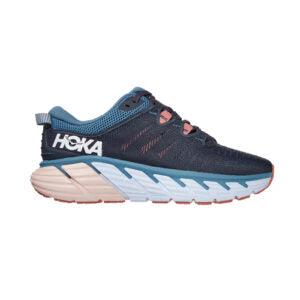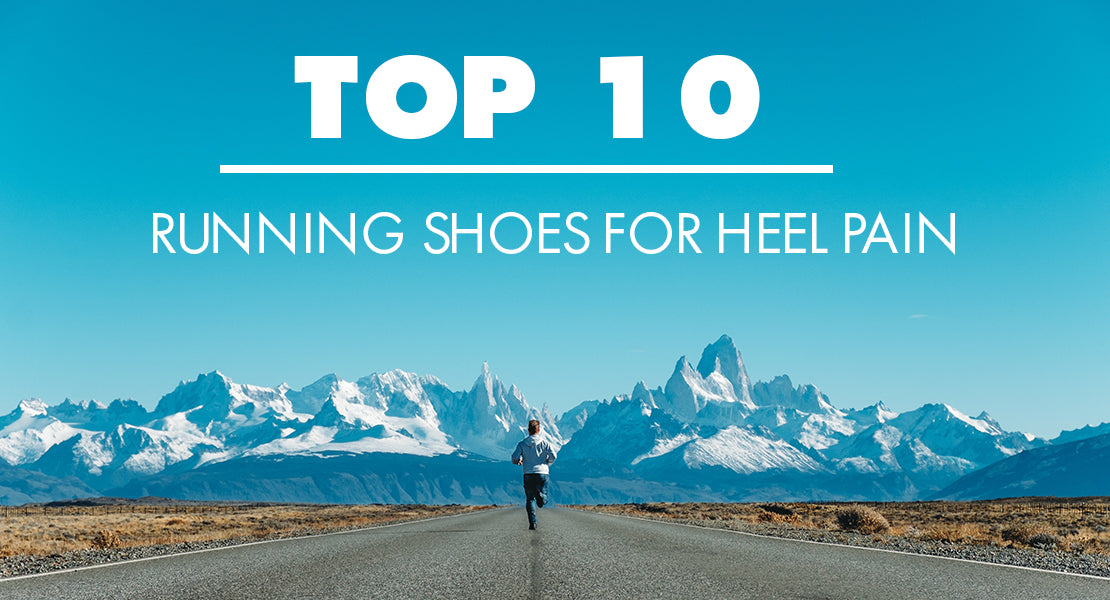More than likely you found this blog because your heels are hurting. Maybe you have heel spurs, plantar fasciitis or maybe you just cannot figure out why they hurt! But to be more specific they’re hurting when you wear your
running shoes! If you keep reading we will talk about why your heels may be hurting when you wear running shoes. Additionally, we will give you a list of
The 10 Best Running Shoes for Heel Pain in 2021:
1. New Balance 990 V5
- 7 Ounces
- 12 mm Drop
- ENCAP® midsole technology provides support and maximum durability
- Dual Density Foam Collar
2. Hoka Bondi 7

- Open-engineered mesh construction delivers breathable comfort
- Memory foam collar cradles ankle in plush comfort
- TPU overlays offer additional midfoot structure and support
- Internal heel counter provides a supportive, locked-in fit midsole
3. Brooks Adrenaline GTS 21
- 6 ounces
- 12 mm Drop
- The asymmetrical 3D Fit Print saddle pulls from the heel and wraps around your arch for a secure fit
- Integrated, streamline GuideRails offer smoother transitions
- Improved structure in the mesh upper shaves weight
4. New Balance 1080 V12
by New Balance features Fresh Foam technology that is precision-engineered to deliver an ultra-cushioned and lightweight ride, which is ideal for combating heel pain. In addition, 1080 also features a Hypoknit upper that is designed to provide strategic areas of stretch and support. Also, the heel features a design that hugs the back of the foot for a snug, supportive fit. Lastly, a durable blown rubber outsole has pressure mapping colors to indicate zones of impact so you can see your running pattern after a run!
- 4 ounces
- 8mm Drop
- Bootie Construction
- Blown Rubber Outsole
5. HOKA Gaviota

- 9 ounces
- 5 mm drop
- Premium Stability Shoe
- The Gaviota 3 also holds the APMA seal of acceptance – The APMA Seal of Acceptance
is awarded to products of exceptional quality that promote good foot health, manufactured with consumer’s comfort and safety in mind.
6. Brooks Ariel 20
- 8 ounces
- 12 mm Drop
- Engineered-mesh upper with comfortable embroidered saddle: provides comfort and a spacious yet secure fit
- BioMoGo DNA midsole: provides ultra-softness and durability
7. Brooks Beast 20
is almost identical in support to the Ariel. The Beast offers an Extended Progressive diagonal Rollbar that guides your body back into its natural motion path, with added support. The new and improved fit of the Beast is soft and features an engineered air mesh upper that offers a spacious toe box, structural saddle, and an external heel counter for reinforced stability while you run! The ultra-cushioned footbed and structural outsole will help aid with the aches and pains in your heels. In addition, the Beast has a full-length segmented crash pad that accommodates any foot landing and delivers smooth heel-to-toe transition. Lastly, an engineered air mesh upper enhances breathability so you can run comfortably in any weather.
- 8 ounces
- 12 mm Drop
- Engineered-mesh upper with comfortable embroidered saddle: provides comfort and a spacious yet secure fit
- BioMoGo DNA midsole: provides ultra-softness and durability
8. Hoka Clifton 8

- Open-engineered sandwich mesh construction delivers the ultimate in breathable comfort
- Lightweight mesh gusset prevents tongue migration
- The reinforced eye stays provide increased durability
- New vertical pull tab for easy entry
9. Brooks Ghost 14

- DNA Loft provides the softest underfoot cushioning for lasting comfort
- Super soft DNA LOFT offers plenty of cushioning underfoot, regardless of how your foot lands
- The new Engineered Air Mesh upper hugs the foot for a secure — but still breathable — fit
- DNA LOFT now extends beyond the heel, all the way to the forefoot, for an easy transition from landing to toe-off
- Co-molding DNA LOFT and BioMoGo DNA delivers a softer feel and smoother transitions than other molding processes
- Incredible stability makes this shoe great for Plantar Fasciitis
- Comes in wide, fitting great for bunions
10. HOKA Akasa
- Ultra-plush dual compound memory foam sock liner for all-day comfort
- Rubberized foam outsole for traction and high-rebound cushioning
- Engineered knit upper provides support, comfort, breathability, and a clean finish for active or casual use
- Complete rubberized foam midsole offers a dynamic and responsive ride
- Textured TPU toe reinforcement for added durability and support
- Balanced Meta-Rocker
What Foot Problems Cause Heel Pain?
- Plantar Fasciitis – When suffering from Plantar Fasciitis, the volume of pain you’ll experience can vary from mild to severe, and most of the pain will be in your heels. The reason your heels are in so much pain is due to the weakest part of the plantar fascia is attached to the heel and when the plantar fascia is repeatedly twisted and pulled, due to lack of arch support, it pulls the connective tissue away from the heel and causes the pain and inflammation in and around the heel.
- Heel Spurs – Most of the time, a heel spur is caused by Plantar Fasciitis. A heel spur forms as the body tries to repair the torn plantar fascia by building extra bone where it has been damaged. It generally forms in response to pressure, rubbing, or stress that continues over a long period of time on the plantar fascia, a heel spur will feel like a bony protrusion.
- Over-Pronation – When the heel makes the initial ground contact but the foot rolls inward more than it should. The reason over-pronation can lead to heel pain is that the plantar fascia is being overstretched, which can then can lead to Plantar Fasciitis.
A pair of shoes that match your foot type and address any existing foot problems is crucial for foot pain relief, preventing discomfort, and further aggravating symptoms. Properly fitting shoes provide the necessary support and cushioning to align your feet and body correctly, reducing the risk of pain and injury. For example, people with flat feet may benefit from shoes with good arch support, while those with plantar fasciitis might need extra cushioning in the heel to not aggravate plantar fasciitis symptoms. By selecting shoes from trustworthy shoe brands designed to meet your specific needs, you can enhance comfort, improve posture, and prevent the worsening of foot conditions.
The next time you go shoe shopping for your new favorite pair, choose Lucky Feet Shoes for stylish, comfortable solutions—in all types of shoes for all types of foot problems—and get a free foot analysis when you visit our stores!

What to look for in good running shoes
When shopping for running shoes, we cannot go solely off of looks. It is extremely important that you invest your time into researching and visiting stores that can help point you in the right direction, but for now, here are a few traits to look for. First, you want to find a shoe that is not flexible, it should not be able to twist and turn, especially fold in half. Secondly, find a shoe that fits your gait cycle. Did you know that there are shoes tailored to the way you walk and run? Finding a shoe that fits your gait cycle can play a big role in helping you recover from heel pain. Finally, you’ll want to make sure your shoes are for running. You never want to run in walking shoes, sure they’re lighter and less bulk but that also means a lot less support and no shock absorption. In all, keep these 3 helpful tips in your back pocket and use them on your next shoe hunt!
Who Is Most Likely to Suffer from Heel Pain?
When it comes to heel pain, it does not discriminate! Anyone, from young to old, short to tall can suffer from heel pain. Here’s a quick list of some people that may be more prone than others:
Runners – tend to put more strain on their feet due to hard impact and shock from running. Additionally, running causes your shoes to breakdown fairly quickly, depending on the surface you’re running on. If you do not replace your shoes when it’s due (around 300 to 500 miles after the first wear) or wear ill-equipped shoes, your body and feet are going to suffer the consequences, especially your heels.
Pregnancy – causes extra weight that your body isn’t used to carrying. When this happens your arch becomes more flexible which can then lead to stretching of the plantar fascia. When the plantar fascia is stretched out excessively, this could lead to plantar fasciitis, whose main symptom is heel pain.
Overweight – When we rapidly gain a large amount of weight over a short period of time our feet become weakened by the weight and cause similar traits to the foot as pregnancy.
Running Shoes for Your Gait Cycle
Did you know that when looking for running shoes, you should try to purchase a shoe that accommodates your gait cycle? But then that leads you to another question, what is my gait cycle? Take a look at the list below for the 3 types of gaits:
Neutral Gait – With a neutral gait, your heel strikes the ground first and then rolls in about 15%, and your weight is properly supported without any issue. Also, at the end of the gait cycle, you push off your foot.
Overpronation – The sequence is the same as a neutral gate, with the exception that your foot rolls in more than 15%. This means the foot is having problems stabilizing and supporting the body. In addition, at the end of the gait cycle, you push off more with your big toe and second toe leaving them to do all of the work.
Supination – With supination, the heel makes contact with the ground, but the foot moves outward (less than 15%) and the impact is on the outside part of the foot. Lastly, in the push-off phase, most of the work is done by the smaller toes on the outside of the foot.
In the end, having a well-supported running shoe is what will help aid in the fight against heel pain. Cushion and stability will become your best friends when searching for a running shoe. If you follow these steps to finding a running shoe that will help with your heel pain then you will be on your way to healthier and happier feet!

Jerick Sobie
Since 2005, I have been a dedicated small business owner specializing in footwear retail. With over 20 years of experience, my business partner and I have helped customers find the perfect shoes that combine style, comfort, and quality. Our expertise extends beyond local sourcing—we have traveled internationally to discover high-quality footwear that meets our customers’ needs. In addition to running my business, I have participated in numerous health fairs and educational seminars, sharing my knowledge on proper footwear and foot health. Committed to providing exceptional service, We carefully curate our selections to ensure the best fit and support for every customer.





























